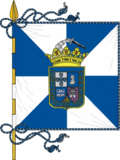Horta, Azores
| Horta | |||
| Municipality (Concelho) | |||
|
The City of Horta and Horta Bay, as seen from Espalamaca, showing the marina, the old dock, and volcanic cones, Monte Escuro and Monte da Guia
|
|||
|
|||
|
Official name: Concelho da Horta Cidade da Horta |
|||
| Name origin: Portuguese transliteration of the first Captain-general of Faial, Josse van Huerter | |||
|
Motto: Mui Leal Cidade da Horta (English: Most Loyal City of Horta) |
|||
| Country | |||
|---|---|---|---|
| Autonomous Region | |||
| Island | Faial | ||
| Civil Parishes | Angústias, Capelo, Castelo Branco, Cedros, Conceição, Feteira, Flamengos, Matriz, Praia do Almoxarife, Praia do Norte, Pedro Miguel, Ribeirinha, Salão | ||
| Landmarks | Cabeço Gordo, Capelinhos | ||
| Center | Caldeira | ||
| - elevation | 404 m (1,325 ft) | ||
| - coordinates | 38°34′46″N 28°42′59″W / 38.57944°N 28.71639°WCoordinates: 38°34′46″N 28°42′59″W / 38.57944°N 28.71639°W | ||
| Highest point | Cabeço Gordo | ||
| - elevation | 1,043 m (3,422 ft) | ||
| - coordinates | 38°34′34″N 28°42′47″W / 38.57611°N 28.71306°W | ||
| Lowest point | Sea level | ||
| - location | Atlantic Ocean | ||
| - elevation | 0 m (0 ft) | ||
| Area | 173.06 km2 (67 sq mi) | ||
| - water | 0.01 km2 (0 sq mi) | ||
| - urban | 10.67 km2 (4 sq mi) | ||
| - metro | 3.12 km2 (1 sq mi) | ||
| Population | 14,994 (2011) | ||
| Density | 87/km2 (225/sq mi) | ||
| Settlement | c. 1467 | ||
| - Town | c. 1498 | ||
| - City/Municipality | 4 July 1833 | ||
| LAU | Câmara Municipal | ||
| - location | Largo Duque de Ávila e Bolama, 48, Matriz | ||
| - elevation | 18 m (59 ft) | ||
| - coordinates | 38°32′15″N 28°37′35″W / 38.53750°N 28.62639°W | ||
| President | José Leonardo Goulart da Silva (PS) | ||
| Municipal Chair | Fernando Manuel Machado Menezes (PS) | ||
| Timezone | Azores (UTC-1) | ||
| - summer (DST) | Azores (UTC0) | ||
| Postal Zone | 9900-997 | ||
| Area Code & Prefix | (+351) 292 XXX XXX | ||
| Patron Saint | Santíssimo Salvador da Horta | ||
| Municipal Holiday | 24 June | ||
|
Location of the municipality of Horta in the archipelago of the Azores
|
|||
| Website: http://www.cmhorta.pt | |||
Horta (Portuguese pronunciation: [ˈɔɾtɐ]) is a single municipality and city in the western part of the Archipelago of the Azores, encompassing the island of Faial. The population in 2011 was 14,994, in an area of 173.06 km². The city of Horta itself has a population of about 7,000.
The marina is a primary stop for yachts crossing the Atlantic, and its walls, and walkways are covered in paintings created by visitors who noted the names of their vessels, crews, and the years they visited. Peter's Cafe Sport, which is located across from the marina and houses the island's scrimshaw museum, a collection artifacts carved from whale tooth and jawbone, is a point of reference for trans-Atlantic yachtsmen and sailors.
In 1467, the Flemish nobleman Josse van Huerter returned to Faial on a second expedition, this time disembarking along the shore of what would be known as Horta bay. He had a small chapel built, that would later form the nucleus of a small community known as Horta (a name derived from the transliteration of his name). The infante D. Fernando, Duke of Viseu, granted Huerter the first captaincy of the island on February 2, 1468. But, the settlement of the island was not chiefly by flemish peasantry or business interests. In fact, generally, settlers to the island were from hard-working farmers from continental Portugal, willing to work hard in new lands, from a cross-section of northern Portugal. But, Huerter cultivated new business opportunities, attracting a second wave of settlers under the stewardship of Willem van der Haegen (later transliterated to Guilherme da Silveira), who brought administrators, tradesmen, settlers and other compatriots to settle on the island.
Huerter's son, Joss de Utra (who would become the second Captain-General), and daughter, D. Joana de Macedo (who married Martin Behaim at the Santa Cruz chapel) continued on Faial, long after van Huerter’s death. By 1498, Horta was elevated to the status of vila (analogous to a town) by decree of King D. Manuel I, as its center grew north from the area around the small chapel of Santa Cruz. The island prospered with exports of wheat and woad. On June 28, 1514 the parish of Matriz do São Salvador da Horta was constituted and services were begun. In 1567, the cornerstone of what would be the Fort of Santa Cruz was laid. The constant growth of the settlers in the villa compelled the creation of the parishes of Nossa Senhora da Conceição (July 30, 1568) and Nossa Senhora da Angustias (November 28, 1684) by the diocese of Angra. As two nuclei developed around Santa Cruz and Porto Pim, growth had also extended around the older Matriz (where the Tower Clock now stands) and the public square (where Alameda Barão de Roches now exists). Public buildings were erected between Rua Visconde Leite Perry and Rua Arriage Nunes, and eventually the town hall and the court offices moved to the former Jesuit College, after the Jesuits were expelled from Portugal in 1758.
...
Wikipedia




